MO Tested: Arai Corsair-X Review

Advances through refinement
Updated May 2021
Arai Corsair-X
| Aesthetics | 9.0/10 |
| Protection | 10.0/10 |
| Value | 8.25/10 |
| Comfort/Fit | 9.0/10 |
| Quality/Design | 10.0/10 |
| Weight | 9.0/10 |
| Options/Selection | 9.0/10 |
| Innovation | 9.75/10 |
| Weather Suitability | 9.5/10 |
| Desirable/Cool Factor | 9.25/10 |
| Overall Score | 92.75/100 |
Premium helmets have always shipped at a premium price, and it’s often been said (even by myself) that the only real difference between premium helmets and bargain ones are the comfort features, like weight, venting, liners, and aerodynamics. Arai wants to correct the misconception that less expensive helmets are just as safe as the premium ones. While they have undergone the same certification testing, Arai stresses that, depending on the certification being sought, having the helmet manufacturers know the exact location of the impact measurements and the order in which they will be applied makes it possible to game the system. To wit, helmets can be constructed to pass a specific certification while offering the manufacturer cost savings in the form of less comprehensive protection on areas which are not measured.
Arai: The Philosophy Behind The Helmets
2010 Arai Corsair V Helmet Review
Arai Managing Director Brian Weston said, during his presentation of the Corsair-X, that “Minimums don’t matter.” Because there’s no way to consistently reproduce a particular kind of crash, “standards are sterilized. They’re made to be done in laboratories to be repeatable.” Lest you think that Arai is saying that standards are bad, that couldn’t be further from the truth. Standards are important, but they are not the be-all, end-all of helmet manufacturing. Rather, standards are the only way we have to systematically certify that a helmet meets minimal protection criteria. Weston emphasizes, ”A helmet’s job has never changed from the very first day. It’s protection.”
Guiding Principles
Consequently, Arai states that the guiding principle behind all its helmets is the desire to provide the best helmet protection possible. Namely, “it’s up to the manufacturer to decide how to deal with… the reality of crashing,” according to Weston. Because the company is not publicly held, it doesn’t have to answer to fickle shareholders and their desire to maximize profits. Instead, being family-owned, Arai has a mandate from the top to “design [helmets] to do what we think is necessary.” Arai has chosen a path of incremental refinement of a core group of principles to guide its helmet design, construction, and protection ethic.
MO Tested: Arai Signet-Q Pro Tour
The root of Arai’s long-standing design principle is the R75 Shape, which specifies that the shell surface above the Snell testing line be a continuous convex curve with a minimum radius of 75mm. Arai posits that most helmet impacts, contrary to how they are tested, are glancing blows. So, the R75 Shape makes the helmet as round as possible and with any protrusions from this curved shaped being designed to break away – to “disappear in a crash” – rather than possibly hook up and cause twisting forces. One need look no further than the venting and diffusors on the top of the helmet to see an obvious physical example of this doctrine. Less obvious, though, is the way the shell construction contributes to the protection of a rider’s head in the bouncing and sliding of a high-speed crash.
Arai helmets utilize an extremely hard exterior shell (Weston stood on an empty shell that was lying on its side to provide a visual example of this strength for the media), which spreads out impact forces. With a larger area to absorb the force, the liner can be constructed of softer material. According to Arai, this makes for a more comfortable fit when riding and less pain for the rider in a mishap. The harder shell is also better able to withstand the multiple impacts of a tumble. Additionally, Arai uses multi-density foams to tune the absorption capabilities of different sections of the helmet.
This construction allowed the Corsair-V to be the first helmet to meet the seemingly contradictory ECE and Snell impact certifications. ECE is a lower peak force threshold, said to be a more street-focused standard, while Snell is said to protect against harder, more track-focused high G-force impacts. Arai’s hard shell and soft liner approach appears to be vindicated by this result.
Relentless Refinement
Just because Arai believes in incremental improvements, doesn’t mean the Corsair-X is just a warmed over Corsair-V. Only three components on Corsair-X were carried over from the V: the bottom trim, breath guard, and rear wing. This is largely due to the new shell and shield system which combine to take the steps toward Arai’s goals of having the exterior be as round and smooth as possible.
The Variable Axis System (VAS) shield arrangement was designed to meet two criteria. First, in response to customer requests, switching shields was made more intuitive and requires less of a leap of faith than the old system. On the X, pressing a lever on either side of the eye port causes the side pods to pop off, exposing the new pivot and release system. Second, the VAS helps Arai to move the shield mount 24mm lower on the shell to create more of the smooth surface on the helmet that the company desires.
Most helmets have the visor pivot located roughly in the same place on the shell to allow the visor to clear the top of the shell when opened. The VAS assists the visor in clearing the helmet top while also pulling the visor in to help tightly seal the eye port from intrusion of wind and/or precipitation. Additionally, a positive latching system adapted from Arai’s Formula 1 helmet was added to the visor. While it doesn’t guarantee that the visor will stay closed in a crash, the new latch hooks to the bottom of the visor to hold it in place. Opening the visor requires that the latch be pushed up to unlock the latch and lift the visor slightly so that the rider’s finger can continue the upward motion with the visor itself. I fumbled with the latch the first two times I exited the track. By the end of the third session, I’d figured it out.
The new shell is lighter, thanks to a updated Peripheral Belting & Structural Net Composite2 (PB SNC2) resin, enabling the complete Corsair-X to weigh about the same as the V even with the additional components mounted on it. The shell is another area where Arai listened to its customers. The chin bar has been altered to allow, when combined with a resculpted chin liner, an extra 3mm of space in front of the rider’s mouth. (Riders who use communication systems will appreciate the additional room for a microphone.) While Arai claims the Corsair-X is still a mid-oval shape, the interior shape is a little longer front-to-back for increased comfort. By popular request, the chin vent is now user-replaceable instead of requiring a trip to an Arai service center as with previous generation Corsair’s.
The rest of the X’s vents also received makeovers. All three of the top vents sport new slide gate closures that, in addition to being easier to operate with gloves, seal better when closed. Additionally, the center vent flows a claimed 11% more air regardless of the rider’s head position, be it a racer tuck or a more upright street riding position. The two vents flanking the center vent were made 20mm longer to improve airflow over the back of the helmet. To minimize turbulence and provide better aerodynamics at street speeds, the vents are also straighter, no longer flaring out at the ends. A bump in front of all three top intakes is responsible, according to Arai, for the center vent’s increased airflow and for the 19% increase in the side vents.
The eye port also benefits from improved air flow. The ASAC air side channel that runs from the corner of the eye port to the new, more aggressive lower side vent now pulls more air and moisture out from behind the visor. Additionally, this new flow allows the brow vents to flow more cooling air into the same space. Since the ASAC runs near the rider’s ears, it is now enclosed to reduce noise. The neck roll exhaust vent is purported to flow the same volume as the V but via a smaller port.
The Corsair-X’s liner also saw improvements. It is thinner and now designed to break away under impact. The temple pads are customizable via removable 5mm sections of padding. While cheek pads of various thicknesses have been available for years, the crown pad also has thicker or thinner options available to suit differing head sizes. The Eco-Pure anti-microbial liner should fend off the dreaded helmet funk while still absorbing moisture. It is removable and washable. The chin curtain is now installed standard on the helmet, and it still allows for the chin spoiler to be pulled down.
Track Tested
Arai assembled the moto-press at Thunder Hill Raceway to test the Corsair-X on the track prior to sending most of the editors home with samples to test on the street. Unfortunately, my XL noggin was not one of the lucky ones which returned home with a new lid. I was able to use an ECE-certified European sample on the track, but for liability reasons, I could not take one home for street testing. The California weather gods made sure that all riders would have their vents open by providing temperatures in the upper 90s. Ducati ponied up Panigales of the 899 and 1299S varieties, and Pirelli served up the hot buns.
Slipping my long-oval head through the Corsair-X’s mid-oval opening was a snug fit, but once inside, my head felt perfectly at home. The front-back fit was a tad tight but, at the track during 20-minute sessions, not hotspot inducing. An Arai technician at the event allowed me to try a 2mm thinner forehead pad but stressed that, because of the softer EPS liner, I’d want the helmet’s initial fit to be quite snug. So, I returned to the thicker liner after a couple sessions.
The venting around the eye port is fabulous. As soon as I closed the visor, before even pulling into the hot pit, I could feel the increased ventilation around my eyes. Once I got up to speed, the venting kept me cool throughout the day. Compared to my previous Arais, the X is fairly quiet – though that is relative given the high speeds and impressive exhaust notes of the Ducatis. Here is where a street test would be nice – the 460 miles back to SoCal would’ve been the ideal time to ponder helmet noise at highway speeds. Still, I expect to be favorably impressed with the Corsair-X quietness on the street. I feel I should mention that, even with the X’s relative quietness compared to current generation helmets, I wore earplugs on the track – as I always do – and so should you.
As with my previous on-track experience with Arais, the Corsair-X felt light on my head and didn’t suffer from any lift at speeds approaching 145 mph on the front straight. Similarly, popping up from behind the bubble and turning my head to look through the corners didn’t elicit any misbehavior from the lid. The best description I can come up with is that the Corsair-X felt less like a helmet I’d strapped on and more like an integral part of my head. When I was riding on the track, I had to make myself concentrate on what the helmet was (or was not) doing rather than having it call attention to itself through fit, stability, or noise issues. That’s about the best we can ask for from a helmet – other than protecting your melon from the slings and arrows of outrageous impacts.
While the eye port has retained its size, the new, thinner liner means a rider’s eyes are not as far away from the exterior edge of the opening. Consequently, the rider’s visual field is slightly increased, particularly at the upper part of the rider’s view when in a tucked position.
Though the visor doesn’t just pop off when you press the lever, switching visors is a much simpler process than before – mostly because you can see everything that you’re doing. You’ll still want to practice the swap a few times so that installing a clear visor at dusk will be quicker when you’re sitting on the side of the road. Also, the included Pinlock visor is a nice touch worthy of a premium-priced helmet, but it was completely unnecessary on our track day.
Taking the Checkers
Although one day on the track can’t reveal how the Corsair-X will perform over time, we can look to Arai’s reputation for quality gear and our past experience to give an educated prediction of high performance worthy of its premium price. Additionally, this test won’t be complete until I get a chance to spend some street miles and hours inside the lid once my size arrives stateside. So, I’ll update it when I do.
Arai has, as evidenced by a day on the track, hit all of its comfort and convenience goals for the Corsair-X. The VAS faceshield system is more than just innovation for innovation’s sake. It helps move the design incrementally towards the smooth surface design goals for protecting riders through promoting glancing blows. The VAS also demonstrates Arai’s commitment to listening to riders by making shield changes easier.
The Corsair-X in sizes XS-2XL will be available in October in Black, Black Frost, White and Aluminum Silver solid colors and in race replicas, including the Hayden, Pedrosa, Vinales, and a special 30th Anniversary Freddie Spencer replica. Pricing ranges from for $839.95 to $849.95 for solid colors. Graphics move the MSRP to $969.95. The MSRPs include a $40 increase over the Corsair-V. To learn more, visit AraiAmericas.com.
Arai Corsair-X | |
| + ProsImproved glancing capabilityBetter airflowUpdated fit | – ConsNot the lightest helmetVisor latch system improved but still a challengeExpensive |
Which is better Shoei or Arai?
Arai and Shoei are two of motorcycling’s premier helmet manufacturers, and as such, you can’t go wrong with either one. Both have many of the features discriminating riders look for in a premium helmet: comfortable fit, good ventilation, removable/washable interior padding, and excellent fit and finish. If you’re looking for a top quality motorcycle helmet, you owe it to yourself to try on both brands. Usually, the determining factor for many riders is how their heads fit in the company’s interpretation of head shape. While it is no longer true that there are Arai heads and Shoei heads, the little details of fit can make a huge difference in rider comfort. Often, riders will pick one of these brands and stay with them for their entire riding career.
Are Arai helmets worth the money?
With a premium helmet, you are paying for much more than just a lid that will pass impact absorption specifications. With Arai, you’re paying for the development of the helmet and the hand construction of each helmet by highly-skilled craftspeople. Then there are the comfort features, ventilation, quietness, and fit and finish. If you want to learn more about what goes into the construction of Arai helmets, hop over to our article about the Arai approach to helmet manufacturing.
Arai: The Philosophy Behind The Helmets
How many shell sizes does the Arai Corsair-X have?
The Arai Corsair-X has four shell sizes, covering head sizes ranging from XS-XXL
Arai Corsair-X Specifications | |
|---|---|
| Price | $840 (solid), $970 (graphic) |
| Sizes | XS-XXL |
| Weight | 3 lbs, 10 oz. (approximately) |
| Colors | White, Black, Aluminum Silver, Black Frost, Matte Black, and various graphics |
Additional Resources

Like most of the best happenings in his life, Evans stumbled into his motojournalism career. While on his way to a planned life in academia, he applied for a job at a motorcycle magazine, thinking he’d get the opportunity to write some freelance articles. Instead, he was offered a full-time job in which he discovered he could actually get paid to ride other people’s motorcycles – and he’s never looked back. Over the 25 years he’s been in the motorcycle industry, Evans has written two books, 101 Sportbike Performance Projects and How to Modify Your Metric Cruiser, and has ridden just about every production motorcycle manufactured. Evans has a deep love of motorcycles and believes they are a force for good in the world.
More by Evans Brasfield



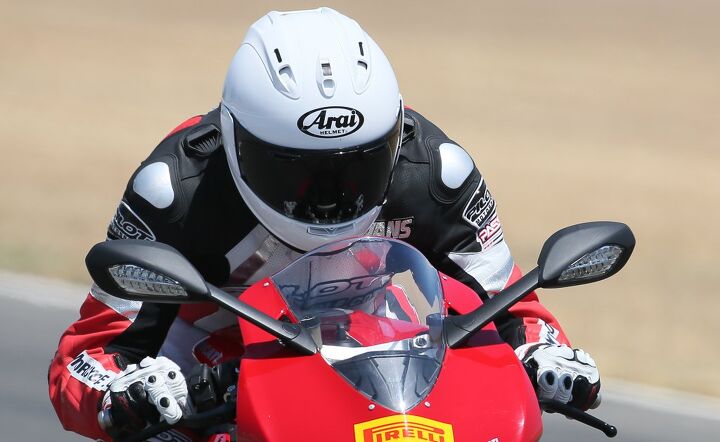

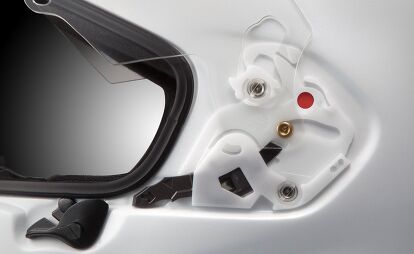
























































































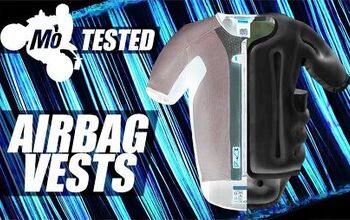
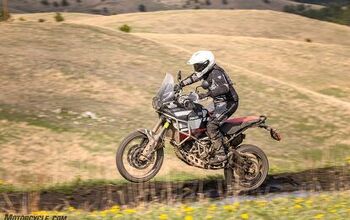



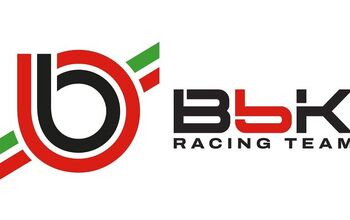











Comments
Join the conversation
Absolutely no evidence exists that this terrific helmet will protect a rider better than a Snell/DOT full face helmet costing $150. There are many reasons why you would buy this helmet over the bargain basement helmet, but safety is really not one of them. "Perceived safety" yes, real world safety, no.
Sounds like some of Aria's language about the validity of testing may have to do with a number of their helmets getting rather mediocre results in the SHARP ( http://sharp.direct.gov.uk/) helmet tests run by the UK Department of Transport.